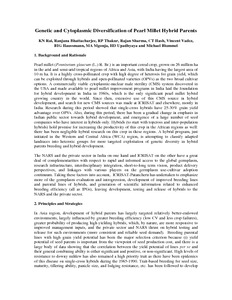Genetic and Cytoplasmic Diversification of Pearl Millet Hybrid Parents
Abstract
Pearl millet (Pennisetum glaucum (L.) R. Br.) is an important cereal crop, grown on 26 million ha in the arid and semi-arid tropical regions of Africa and Asia, with India having the largest area of 10 m ha. It is a highly cross-pollinated crop with high degree of heterosis for grain yield, which can be exploited through hybrids and open-pollinated varieties (OPVs) as the two broad cultivar options. A commercially viable cytoplasmic-nuclear male sterility (CMS) system discovered in the USA and made available to pearl millet improvement programs in India laid the foundation for hybrid development in India in 1960s, which is the only significant pearl millet hybrid growing country in the world. Since then, extensive use of this CMS source in hybrid development, and search for new CMS sources was made at ICRISAT and elsewhere, mostly in India. Research during this period showed that single-cross hybrids have 25-30% grain yield advantage over OPVs. Also, during this period, there has been a gradual change in emphasis in Indian public sector towards

